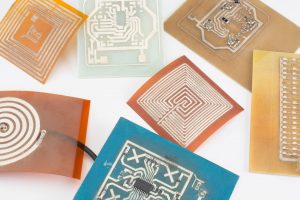
3D Printing of electronic devices to hit $420-Million
Stephen Law
Electronics Production / Materials Contract Manufacturing EngineeringOpportunities for 3D printing in the electronics industry will generate $428-million in revenues by 2022 and go on to achieve $2.8-billion in revenues by 2025, according to a recent SmarTech Publishing report that identifies and quantifies the commercial opportunities presented by 3D printing of electronic components and related circuitry.
The report underscores growing interest in using 3D printing to fabricate customized circuitry, sensors and antennas, with longer-term applications possible for other types of electronic components. While the current focus is on prototyping, there is also clearly an opportunity to use 3DP for electronic devices that are regularly produced in relatively low volumes – high speed optoelectronics and military/aerospace electronics are good examples here. In the consumer electronics space there is also a high potential 3D printers both for product design and for mass customization of products such as cell phone cases.
The initial market driver for 3D-printed electronics is to enable multilayer PCB prototyping without the costs and delays associated with service bureau. However, we anticipate that traditional prototyping shops, 3D service bureau and retail mass customization booths will quickly adopt 3D printed electronics. By 2022, service revenues from 3D printing will have reached well over $300 million. Specialist 3D printing service bureaus already exist in the aerospace and medical sectors and there is no good reason why such bureaus should not be created in the 3D-printed electronics space.
Current 3D print use is occasional-use prototyping
Much of the activity in the 3D printed electronics space for the next few years will be occasional-use prototyping, so revenues from the use of inks and powders for this sector is not expected to be large. For example, in 2022, we anticipate that revenues from materials for 3D printed electronics will be around $65 million. However, once 3D printers start to be used extensively to make low-volume electronic and optical components revenues will leap, reaching almost $300 million by 2024. There will also be a growing range of materials available for 3D printing electronics parts. While much of the activity today involves nanosilver inks, new 3D printed materials will emerge including nickel, semiconductor and optical inks.
The current excitement over printing of electronics devices has been driven by the appearance of a handful of firms that are offering specialist 3D electronics printer, sold with a number of semi-proprietary materials. Often these packages are aimed at those who want to prototype multilayer PCBs. For now, the established 3D printer firms have bigger fish to fry. However, over the next few years, we expect that the major 3D printing OEMs – Stratasys or HP, say — will start to address electronics industry applications. Potentially, there are genuinely revolutionary leaps forward in which 3DP and nanomanufacturing capabilities are combined enabling 3D printing to occur at very high resolutions making (say) 3D memory chips a possibility for 3D printing.

